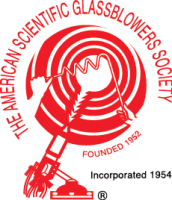(Click on the presenter name to see a short bio.)
Robert Ponton – “Batman, the Lone Ranger and the Chemist”
Batman had Robin, the Lone Ranger had Tonto and of course. The Chemist has The Glassblower! The relationship between scientists and the glass shop dates from the earliest alchemist to the modern day research laboratory.
This paper will be presented as a talk glassblowers can give to other groups like The American Chemical Society, Sigma Xi and others. We will hop scotch through history as we document the long rich history of scientific collaboration between the scientist and the glassblower.
Alexander V. Zabula and Tracy Drier – “Structure and transformation of Glass” -Department of Chemistry, University of Wisconsin-Madison, Madison, WI (USA)
Glass was one of the first artificial materials created at the earliest stages of civilization. Currently, a great amount of various glass materials are fabricated to satisfy the esthetic, practical, and scientific demands of our modern society. The unique properties of glass originate from its structure. From a physical viewpoint, glass behaves both as a liquid and a solid substance. The amorphous nature of glass and lack of long-range translation periodicity significantly limits the number of physical-chemical instrumentation techniques applicable for structural analysis.
In this overview, the most important structural properties of glass including softening, melting, stresses, defects, color, polarization and dichroic effects as well as photosensitivity will be discussed. Special attention will be centered around the structural modifications of glass upon common glassblowing manipulations.
Brian Markowicz – “Manufacture and Maintenance of Glassware used in Isotopic Analysis”
Scientific Glassblower, Chemistry & Biochemistry, Georgia Tech College of Science. Atlanta, Georgia (USA)
The purpose of this paper is to explore the types of glassware that I have been asked to manufacture and/or maintain for the purpose of preparing samples for isotopic analysis. This includes traditional vacuum lines used for the loading of samples and standards for combustion, as well as vacuum lines for the cleaning, separation, measurement and bottling of sample gases for use in isotope ratio mass spectrometry. I will also cover a lesser known sample prep line used to convert carbon dioxide into the graphite powder that is needed for age dating by Accelerator Mass Spectrometry.
Tsuyoshi Nakamura – “Making a Cube Trap”
(Japan)
How to make a complex small cube trap including techniques of how to cut the glass, drilling flat glass, fusion of glass plates and assembling of all parts.
Kevin E. Bennet and Steven M. Anderson – “Chemical Vapor Deposition of Diamonds for Deep Brain Stimulation”
Scientific Glassblowers, Mayo Clinic Invention Labs. Rochester, Minnesota (USA)
The design and fabrication of a chemical vapor deposition reactor for the creation of diamond with boron doping is key to neurotransmitter detection in the brain. We describe the design and construction of a reactor successfully used to synthesize diamond. The process was used to fabricate chemical sensing deep brain probes using fast scan cyclic voltammetry. These electrodes are being used to develop an understanding of deep brain stimulation with the goal of developing a system with active control.
Joseph S. Gregar– “A Few of My Favorite Hints That Could be Helpful”
Argonne National Laboratory 9700 S. Lemont, Illinois (USA)
This paper will highlight a few of my “favorite” hints, tips, tools and tricks that I have learned and used throughout my 49 year scientific glassblowing career. Hopefully some of you are already using them, but everyone should pick up something new and helpful.
Richard Ponton – “Design Mathematics for the glass shop II: the dreaded sequel.”
Scientific Glassblower, The Procter & Gamble Company. Cincinnati, OH (USA)
Continuing on from my 2012 paper, I will briefly review the volume and surface area formulas previously discussed. I will then expand on the material by discussing ellipsoids and how to estimate values for them. I will also discuss how to precisely estimate the linear amount of glass needed to create a bead of a specific size, and finally, I will discuss the simple task of resizing tubing and the not so simple task of calculating the resulting wall thickness of the newly resized tubing.
Erin Austerberry, Jennifer Langill and S. Elayne Ashley – “My Experience at Salem College”
Scientific Glass Technology Students, Salem Community College, Salem, New Jersey, (USA)
S. Elayne Ashley – Salem Community College, Then & Now. The view of life as a Salem scientific glassblowing student will discuss coursework, projects and challenges presented to students. An overview of the history and recent change in the facility and the structure of the program will be included along with photographs of the facility, projects, and student work.
Jennifer Langill – A view of the chemistry program taught as part of the Scientific Glass Technology degree at Salem Community College including a compilation of student projects.
Erin Austerberry – My section of this paper discusses a reaction performed by a student in “Basic and Organic Chemistry for Glassblowers” at Salem Community College. This class is typically taken the second year of the Scientific Glass Technology program. The students each pick an Organic Chemistry reaction, build the apparatus and execute the reaction for the class. The reaction highlighted in this paper used steam distillation to extract clove oil from cloves and then test for the presence of Eugenol in the oil. The reaction was successful.

